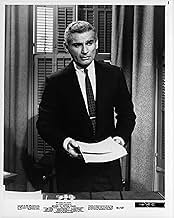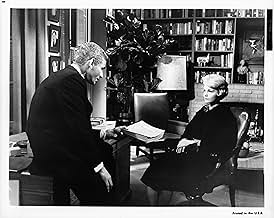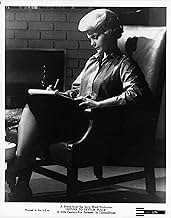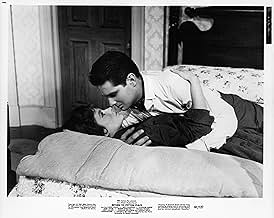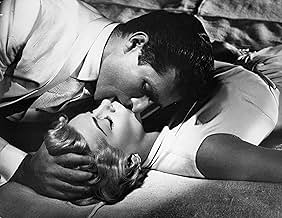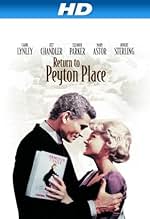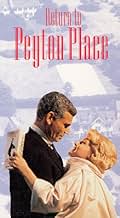AVALIAÇÃO DA IMDb
5,9/10
1 mil
SUA AVALIAÇÃO
Adicionar um enredo no seu idiomaThe residents of Peyton Place are not happy when its most famous resident, Alison Mackenzie, writes a "shocking" novel detailing the sinful secrets of the town.The residents of Peyton Place are not happy when its most famous resident, Alison Mackenzie, writes a "shocking" novel detailing the sinful secrets of the town.The residents of Peyton Place are not happy when its most famous resident, Alison Mackenzie, writes a "shocking" novel detailing the sinful secrets of the town.
- Direção
- Roteiristas
- Artistas
Gunnar Hellström
- Nils Larsen
- (as Gunnar Hellstrom)
Tom Anthony
- Townsman at Meeting
- (não creditado)
Walter Bacon
- Townsman at Meeting
- (não creditado)
Joan Banks
- Mrs. Humphries
- (não creditado)
Helen Bennett
- Interviewer
- (não creditado)
George Boyce
- Townsman at Meeting
- (não creditado)
Bill Bradley
- Mark Steele
- (não creditado)
Ralph Brooks
- Townsman
- (não creditado)
Robert Buckingham
- Waiter
- (não creditado)
- Direção
- Roteiristas
- Elenco e equipe completos
- Produção, bilheteria e muito mais no IMDbPro
Avaliações em destaque
After reading a feature article about Grace Metalious (the 1950's "Pandora in blue jeans") in the Baltimore Sun a few years ago, I read "Peyton Place" twice and then watched both the original film and this sequel. I'd seen the latter in the theater when it first came out and it's funny what time and your own experiences can do to an old film like "Return." Having become a writer myself, I was fascinated by Jeff Chandler as the editor who tells Allison MacKenzie what it takes to become a real writer, not just a talented kid with an idea. Chandler's constant reference to a great editor (I suspect the man he refers to was based on a real-life editor) who MADE such talented wannabes into writers by giving their books shape and direction and Chandler's tutelage of Allison made "Return to Peyton Place" fascinating to me. Fans of the original "Peyton Place" will have to adjust to the change of cast, but this sequel has its own strong performers, like Mary Astor as a domineering mother and Carol Lynley, her beauty in full bloom and quite competent as Allison. I thought Gunnar Helstrom also stood out and this entire effort is worth a look.
On the big, wide CinemaScope screen of the Fox Village Theater in Westwood, in West Los Angeles, California, where I saw this one first-run, I settled in with some rather high expectations as the lovely theme song was beautifully sung by Rosemary Clooney, while stunning vistas of New England beauty followed one another over the opening credits.
Alas, my hopes were quickly dashed and, as other IMDb comments attest, this followup to the very successful "Peyton Place" was a severe disappointment in most respects. The handsome cast was strangely set adrift amidst some rather drab production values and only Mary Astor was given enough to do and was allowed to do it well as the town's tyrannical matriarch. Her final scene is an example of an actress still in full command of her powers convincing an unwilling cinema audience (though not her fellow townspeople on screen) that being a prude and a social snob is a desirable way to live one's life!
Jose Ferrer as a director was never much of a visual stylist so the VHS tape of this CinemaScope production, most probably not letterboxed, might satisfy the curious who want to see an example of studio product that was mired in a soon to be abandoned estimation of what audiences of that day really wanted to see.
Alas, my hopes were quickly dashed and, as other IMDb comments attest, this followup to the very successful "Peyton Place" was a severe disappointment in most respects. The handsome cast was strangely set adrift amidst some rather drab production values and only Mary Astor was given enough to do and was allowed to do it well as the town's tyrannical matriarch. Her final scene is an example of an actress still in full command of her powers convincing an unwilling cinema audience (though not her fellow townspeople on screen) that being a prude and a social snob is a desirable way to live one's life!
Jose Ferrer as a director was never much of a visual stylist so the VHS tape of this CinemaScope production, most probably not letterboxed, might satisfy the curious who want to see an example of studio product that was mired in a soon to be abandoned estimation of what audiences of that day really wanted to see.
I was pleasantly surprised that RETURN TO PEYTON PLACE wasn't as bad as I'd remembered it to be - it's a well-mounted film, again produced by Jerry Wald (who produced, among other classics, MILDRED PIERCE), but neither as glossy-slick nor as compelling as its predecessor. It suffers from the same fate most sequels do, no matter how well-done or well-intended: the magic that sparked the original is simply gone and cannot be recaptured.
RETURN, of course, is a thinly-veiled account of some of what happened to author Grace Metalious after PEYTON PLACE became the publishing phenomenon of the 1950s (no indeed, the townsfolk were not too fond of their "Pandora in Blue Jeans," as she was called, and, if memory serves, did indeed fire her schoolteacher husband). But it's kind of inconceivable that Metalious's novel would have been published at all if she'd been the snotty bitch portrayed by Carol Lynley - no publisher would have put up with such an attitude from an unknown, first-time novelist.
CLEOPATRA's budget was straining the coffers at Fox, so the cast is not as big as PEYTON PLACE, nor, with three exceptions, as notable. Three Hollywood veterans - Eleanor Parker, Mary Astor, and Jeff Chandler, show the young folks how it's done, and Astor, selfish and manipulative as were two other characters she played (Brigid O'Shaughnessy in THE MALTESE FALCON, and Sandra Kovack in THE GREAT LIE, for which she won an Oscar) simply walks off with the film. We don't like Roberta Carter, or the censorship she tries to impose, but we understand her resistance to change, to losing the values and things she holds dear (including her son). And, unfortunately, Astor/Carter's advisory to the people of Peyton Place that they will live to regret their willingness to encourage such changes in morals as Allison's book seems to exemplify, was a sad prediction of the painful price we would pay in the 1980s for the sexual freedom of the 1960s.
RETURN, of course, is a thinly-veiled account of some of what happened to author Grace Metalious after PEYTON PLACE became the publishing phenomenon of the 1950s (no indeed, the townsfolk were not too fond of their "Pandora in Blue Jeans," as she was called, and, if memory serves, did indeed fire her schoolteacher husband). But it's kind of inconceivable that Metalious's novel would have been published at all if she'd been the snotty bitch portrayed by Carol Lynley - no publisher would have put up with such an attitude from an unknown, first-time novelist.
CLEOPATRA's budget was straining the coffers at Fox, so the cast is not as big as PEYTON PLACE, nor, with three exceptions, as notable. Three Hollywood veterans - Eleanor Parker, Mary Astor, and Jeff Chandler, show the young folks how it's done, and Astor, selfish and manipulative as were two other characters she played (Brigid O'Shaughnessy in THE MALTESE FALCON, and Sandra Kovack in THE GREAT LIE, for which she won an Oscar) simply walks off with the film. We don't like Roberta Carter, or the censorship she tries to impose, but we understand her resistance to change, to losing the values and things she holds dear (including her son). And, unfortunately, Astor/Carter's advisory to the people of Peyton Place that they will live to regret their willingness to encourage such changes in morals as Allison's book seems to exemplify, was a sad prediction of the painful price we would pay in the 1980s for the sexual freedom of the 1960s.
Lacking the better cast and production of the original, RETURN TO PEYTON PLACE is only a mediocre movie. In this sequel, Allison MacKenzie (CAROL LYNLEY) has written a novel about the citizens of her hometown, many of whom are less than thrilled. While Allison is in New York finalizing the publication of her work she falls for married publisher Lewis Jackman (JEFF CHANDLER). Back home,Allison's stepfather school principal Mike Rossi (ROBERT STERLING) is being threatened with removal from his post by schoolboard trustee Roberta Carter (MARY ASTOR) if he dares to stock Allison's book in the high school library. Roberta is also busy trying to destroy her son Ted's (BRETT HALSEY) marriage to his new bride Raffaella (A pre THUNDERBALL LUCIANNA PALUZZI). An additional concern for Roberta is keeping the town incest rape victim Selena (TUESDAY WELD), who is also the centerpiece of Allison's novel, away from son Ted. The characters of Allison and her mother Constance (ELEANOR PARKER) were the mainstays in the original. Here they become almost secondary when you watch MARY ASTOR wipe the floor with everyone in this film. Nobody can stare you down like ASTOR ! Nor can anyone in this movie match her subtle gestures or command. Telling his mother that his bride is a nice girl after she has insinuated differently, ASTOR adds, "Maybe it's the way she dresses." LYNLEY is over dramatic after her first 20 minutes. CHANDLER comes across as a dullard. WELD holds her own fairly well, except for an over the top semi flashback scene with new ski instructor boyfriend Nils (GUNNAR HELSTROM), where she proceeds to get hysterical and belt him with a fireplace poker. Veteran PARKER doesn't have much to work with here, but does admirably. PALUZZI is beautiful, but no match for sparring partner ASTOR. Sometimes you're better off not seeing what became of your favorite characters.
1. You get to see Robert Crane of Hogan's Heroes in an "Ed McMahon" type role to somebody else doing a "Johnny Carson". Actually he's acting more like Jack Paar.
2. The first 45 minutes of the movie take place on what seems to be two days before thanksgiving. Then on thanksgiving morning, they show a scene of New York at dawn - and the streets are totally deserted!!!!
3. You get to see this 1960 era turkey as a prop and boy, were turkeys skinny back before corporate farming took over.
4. Everything was so wholesome back then. Except when a woman (the Italian actress) has an unwanted pregnancy. Then she tries to lose it by having a skiing accident because abortions were illegal back then, silly.
5. I've been to Camden, Maine, several times, and the locals told me that they shot none of this movie up there (they filmed the original peyton place there in 1956).
6. Peyton Place was set in 1941-43; this movie never sets a year but if you figure by the fact that the young lawyer just got through law school and that takes 7 years from the start of college, and he was in the war until 1945, that would make this about 1952 I guess. Or maybe its supposed to be current with the release date and be 1961; they never explain this.
7. There is nothing said about several of the characters of the earlier movie that had prominent roles (such as the town doctor and Allison's boyfriend). Why are two such good looking girls still unmarried during that era anyway? Obvious plot loopholes.
8. This movie has an old fashioned look and feel to it even for 1960-61 standards. Within 3-4 years clothing, hairstyles, speech, and mannerisms were significantly different. It's like a time capsule movie of a small town America just before all the crappy changes that took place in the 1960s.
9. It has a really good ending. I found myself actually siding with the old biddy who is singlehandedly trying to enforce the old Puritan moral code of her era against the will of apparently the entire rest of the town, who want to change with the times and let everybody do their own thing. She walks out of the town hall meeting in silence and totally defeated; terrific symbolism, and almost supernaturally prophetic in what actually happened across the country over the rest of the decade.
10. Last but not least, the man who plays the character "Dexter" (he has about 1 line; he is a school board member who is a weak character and the old biddy uses him as a supporter)...this guy was on a lot of the old three stooges shorts. He always played a bad guy, and I've never seen him on any other serious movie.
2. The first 45 minutes of the movie take place on what seems to be two days before thanksgiving. Then on thanksgiving morning, they show a scene of New York at dawn - and the streets are totally deserted!!!!
3. You get to see this 1960 era turkey as a prop and boy, were turkeys skinny back before corporate farming took over.
4. Everything was so wholesome back then. Except when a woman (the Italian actress) has an unwanted pregnancy. Then she tries to lose it by having a skiing accident because abortions were illegal back then, silly.
5. I've been to Camden, Maine, several times, and the locals told me that they shot none of this movie up there (they filmed the original peyton place there in 1956).
6. Peyton Place was set in 1941-43; this movie never sets a year but if you figure by the fact that the young lawyer just got through law school and that takes 7 years from the start of college, and he was in the war until 1945, that would make this about 1952 I guess. Or maybe its supposed to be current with the release date and be 1961; they never explain this.
7. There is nothing said about several of the characters of the earlier movie that had prominent roles (such as the town doctor and Allison's boyfriend). Why are two such good looking girls still unmarried during that era anyway? Obvious plot loopholes.
8. This movie has an old fashioned look and feel to it even for 1960-61 standards. Within 3-4 years clothing, hairstyles, speech, and mannerisms were significantly different. It's like a time capsule movie of a small town America just before all the crappy changes that took place in the 1960s.
9. It has a really good ending. I found myself actually siding with the old biddy who is singlehandedly trying to enforce the old Puritan moral code of her era against the will of apparently the entire rest of the town, who want to change with the times and let everybody do their own thing. She walks out of the town hall meeting in silence and totally defeated; terrific symbolism, and almost supernaturally prophetic in what actually happened across the country over the rest of the decade.
10. Last but not least, the man who plays the character "Dexter" (he has about 1 line; he is a school board member who is a weak character and the old biddy uses him as a supporter)...this guy was on a lot of the old three stooges shorts. He always played a bad guy, and I've never seen him on any other serious movie.
Você sabia?
- CuriosidadesBrett Halsey and Luciana Paluzzi, who played husband and wife in this film, were actually married at the time.
- Erros de gravaçãoAlthough this sequel picks up just several years after original story ends in the early-mid Forties, the new story occurs 15 years later with barely-aged characters living in the early Sixties.
- ConexõesFeatured in Film Review: In Cold Blood/Glossies (1968)
- Trilhas sonorasThe Wonderful Season of Love
Music by Franz Waxman
Lyrics by Paul Francis Webster
Performed by Rosemary Clooney
Principais escolhas
Faça login para avaliar e ver a lista de recomendações personalizadas
- How long is Return to Peyton Place?Fornecido pela Alexa
Detalhes
- Data de lançamento
- País de origem
- Idioma
- Também conhecido como
- El regreso a la caldera del diablo
- Locações de filme
- Empresas de produção
- Consulte mais créditos da empresa na IMDbPro
Bilheteria
- Orçamento
- US$ 1.785.000 (estimativa)
- Tempo de duração2 horas 3 minutos
- Cor
- Proporção
- 2.35 : 1
Contribua para esta página
Sugerir uma alteração ou adicionar conteúdo ausente

Principal brecha
By what name was De Volta à Caldeira do Diabo (1961) officially released in India in English?
Responda

